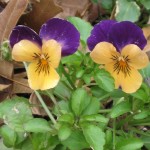 I checked the mailbox earlier today in discovered I received my Park’s package. Yay, more seeds! I took a quick trip to the Lewisville Home Depot in search of some seedling flat trays, but all I walked out with were 2 packages of Burpee growing pellets and 20 feet of garden fencing. Thankfully, my honey picked up a spray bottle for me earlier in the day, so I can mist the alyssum and impatiens trays.
I checked the mailbox earlier today in discovered I received my Park’s package. Yay, more seeds! I took a quick trip to the Lewisville Home Depot in search of some seedling flat trays, but all I walked out with were 2 packages of Burpee growing pellets and 20 feet of garden fencing. Thankfully, my honey picked up a spray bottle for me earlier in the day, so I can mist the alyssum and impatiens trays.
Also, I had earlier shaken some seeds out of the purple pastel salvia greggii sitting potted up in the garden and placed 2 of them into a 3″ pot. I still had plenty of aluminum cake pans to tap, and so proceeded to get some more 3″ pots into them, including the 2 rooted asters I brought indoors. I’m minded to browse the white salvia in the salvia row for some more seeds. I realize that salvia greggii may not always come true from seed, but I think this will be a good experiment to see how well they germinate.
So, to sum up, I sowed 12 21st Century Blue Star Phlox and 1 row of 6 Blue Knoll Chrysanthemum seeds in the Burpee grow system. Both packages had an expiration date, and the Blue Knoll was marked as “low germination” so I’m crossing my fingers to see what the results will be.
I will hold off another week before I sow the marigolds and the vincas, since my focus for now is on cool season annuals such as phlox, alyssum, and impatiens. Meanwhile, I eagerly await the rest of my seed orders…from Burpee and Swallowtail Gardens. My live plant orders from Delaware however have been delayed due to inclement weather.










